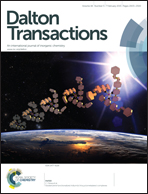Sol–gel syntheses, luminescence, and energy transfer properties of α-GdB5O9:Ce3+/Tb3+ phosphors†
Abstract
Sol–gel method was applied to prepare homogenous and highly crystalline phosphors with the formulas α-GdB5O9:xTb3+ (0 ≤ x ≤ 1), α-Gd1−xCexB5O9 (0 ≤ x ≤ 0.40), α-GdB5O9:xCe3+, 0.30Tb3+ (0 ≤ x ≤ 0.15) and α-GdB5O9:0.20Ce3+, xTb3+ (0 ≤ x ≤ 0.10). The success of the syntheses was proved by the linear shrinkage or expansion of the cell volumes against the substitution contents. In α-GdB5O9:xTb3+, an efficient energy transfer from Gd3+ to Tb3+ was observed and there was no luminescence quenching. The exceptionally high efficiency of the f–f excitations of Tb3+ implies that these phosphors may be good green-emitting UV-LED phosphors. For α-Gd1−xCexB5O9, Ce3+ absorbs the majority of the energy and transfers it to Gd3+. Therefore, the co-doping of Ce3+ and Tb3+ leads to a significant enhancement in the green emission of Tb3+. Our current results together with the study on α-GdB5O9:xEu3+ in the literature indicate that α-GdB5O9 is a good phosphor host with advantages including controllable preparation, diverse cationic doping, the absence of concentration quenching, and effective energy transfer.


 Please wait while we load your content...
Please wait while we load your content...